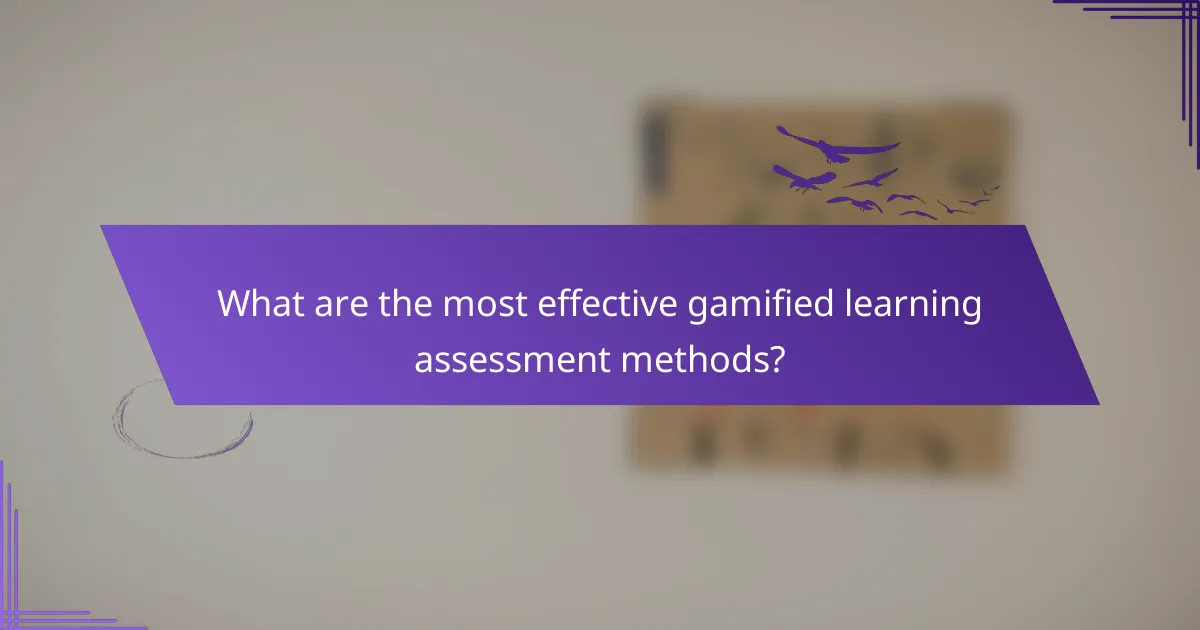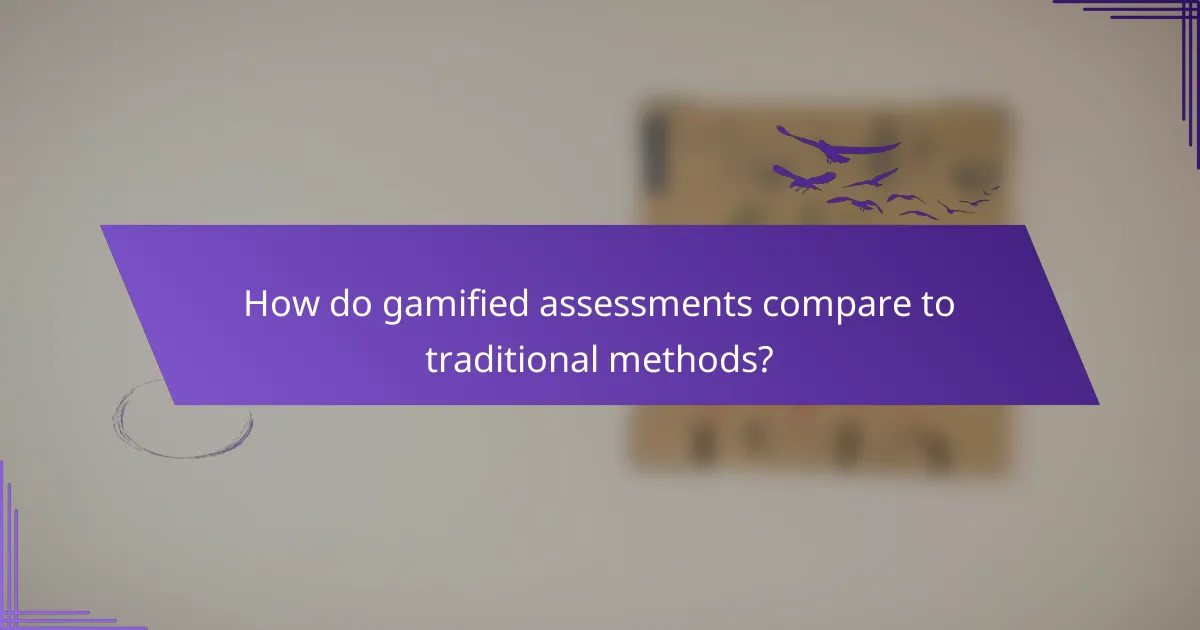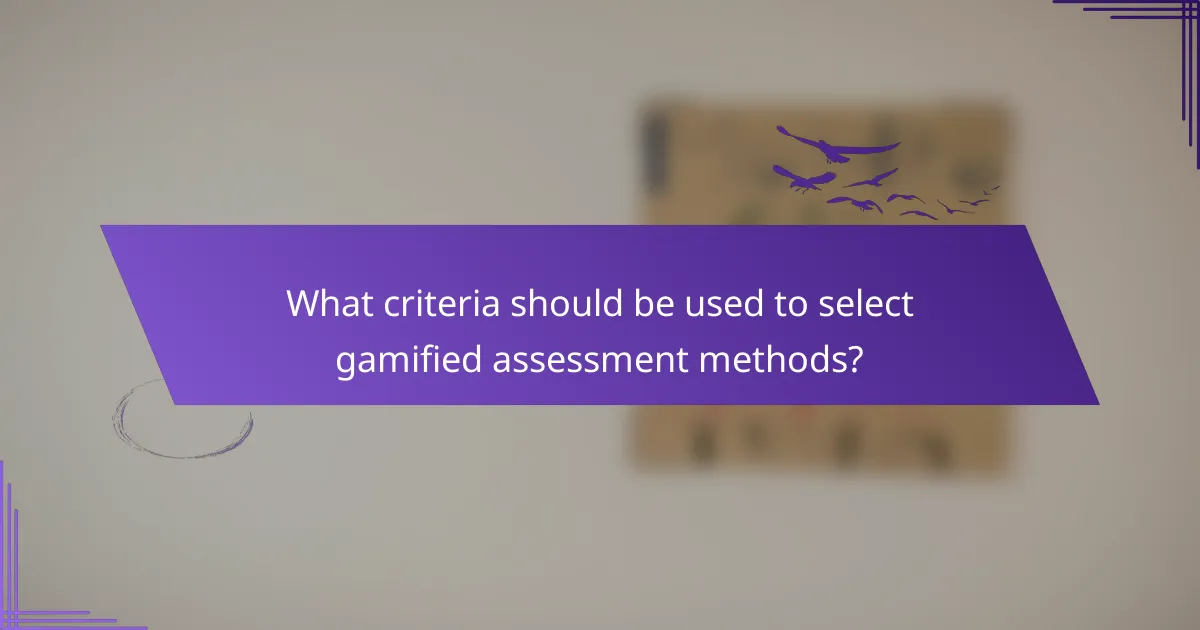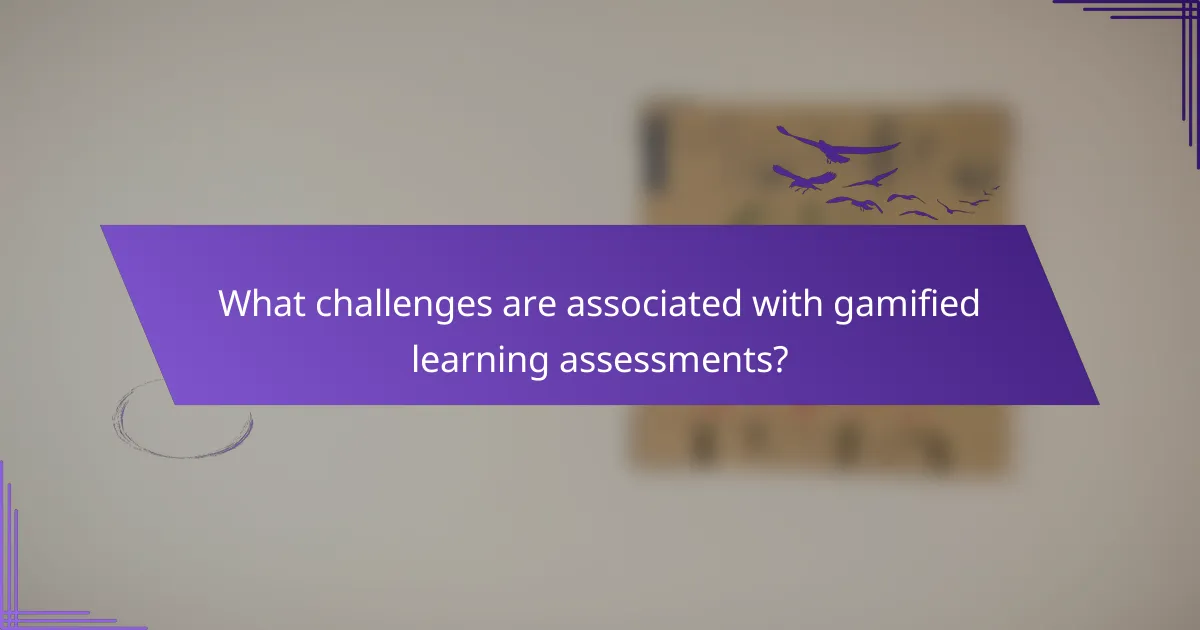Gamified learning assessment methods have emerged as a powerful tool to enhance learner engagement and motivation through interactive experiences. By incorporating game mechanics, these assessments not only make the learning process enjoyable but also provide valuable insights into learner performance. Selecting the right gamified approach requires careful consideration of the target audience, alignment with learning objectives, and accessibility of technology to ensure effectiveness and practicality.

What are the most effective gamified learning assessment methods?
The most effective gamified learning assessment methods engage learners through interactive experiences that enhance motivation and retention. These methods leverage game mechanics to create assessments that are not only enjoyable but also provide valuable insights into learner performance.
Adaptive Learning Platforms
Adaptive learning platforms tailor educational content to individual learner needs, adjusting in real-time based on performance. This personalized approach helps identify strengths and weaknesses, allowing for targeted skill development. Examples include platforms like DreamBox and Smart Sparrow, which adapt lessons based on user interactions.
When selecting an adaptive learning platform, consider the ease of integration with existing systems and the ability to track progress over time. Ensure that the platform aligns with educational goals and offers a variety of content types to keep learners engaged.
Game-Based Assessments
Game-based assessments incorporate elements of gameplay into testing, making the evaluation process more engaging. These assessments can include quizzes that resemble video games or challenges that require problem-solving skills. Popular examples include Kahoot! and Quizizz, which create a competitive atmosphere that motivates learners.
To implement game-based assessments effectively, focus on clear objectives and ensure that the gameplay mechanics align with learning outcomes. Avoid overly complex games that may distract from the assessment’s purpose, and provide immediate feedback to enhance learning.
Simulation-Based Learning
Simulation-based learning immerses learners in realistic scenarios where they can apply knowledge and skills in a controlled environment. This method is particularly effective in fields like healthcare and engineering, where practical experience is crucial. Tools like Labster and SimCityEDU offer simulations that replicate real-world challenges.
When using simulation-based learning, ensure that the scenarios are relevant and reflect real-life situations learners may encounter. Provide debriefing sessions to discuss outcomes and reinforce learning, and consider the technical requirements for running simulations effectively.
Quizzes with Leaderboards
Quizzes with leaderboards introduce a competitive element that can motivate learners to perform better. By ranking participants based on their scores, these assessments encourage engagement and foster a sense of community. Platforms like Socrative and Quizlet enable this feature, making learning more dynamic.
To maximize the effectiveness of quizzes with leaderboards, set clear rules and time limits to maintain excitement. Be mindful of the potential for competition to discourage some learners; consider offering rewards or recognition for all participants to promote inclusivity.
Interactive Scenarios
Interactive scenarios present learners with decision-making opportunities that require critical thinking and application of knowledge. These scenarios can be used in various subjects, from business to social studies, and often involve branching narratives where choices lead to different outcomes. Tools like Articulate Storyline and Twine facilitate the creation of such scenarios.
When designing interactive scenarios, ensure that they are engaging and relevant to the curriculum. Provide feedback on decisions made within the scenario to reinforce learning, and consider incorporating multimedia elements to enhance the experience.

How do gamified assessments compare to traditional methods?
Gamified assessments often enhance engagement and motivation compared to traditional methods, which can lead to improved learning outcomes. While traditional assessments focus on rote memorization and standardized testing, gamified approaches incorporate game elements to create a more interactive and enjoyable learning experience.
Engagement Levels
Gamified assessments significantly boost engagement levels by incorporating elements like points, badges, and leaderboards. These features motivate learners to participate actively, as they can see their progress and compete with peers. In contrast, traditional assessments may feel monotonous, leading to lower participation rates and less enthusiasm.
For example, a gamified quiz might allow students to earn points for correct answers and unlock levels, making the learning process more dynamic. This can result in higher retention of information as students are more likely to invest time and effort in the learning experience.
Knowledge Retention
Knowledge retention tends to be higher in gamified assessments due to the interactive nature of the learning process. When learners engage with content through games, they often remember information better because they associate it with positive experiences. Traditional assessments, which typically rely on memorization, may not foster the same level of long-term retention.
Research suggests that gamified learning can improve retention rates by 20-30% compared to conventional methods. This is particularly beneficial in subjects that require critical thinking and application of knowledge, as gamified assessments often simulate real-world scenarios.
Feedback Timeliness
Gamified assessments provide immediate feedback, allowing learners to understand their mistakes and correct them on the spot. This instant feedback loop is crucial for effective learning, as it helps students adjust their strategies and deepen their understanding. Traditional assessments, however, often involve delayed feedback, which can hinder the learning process.
For instance, in a gamified environment, a student may receive instant notifications about their performance after each question, enabling them to learn continuously. In contrast, traditional tests might take days or weeks to grade, leaving students without guidance during that critical learning period.

What criteria should be used to select gamified assessment methods?
Selecting gamified assessment methods involves evaluating criteria such as the target audience’s needs, alignment with learning objectives, and technology accessibility. These factors ensure that the chosen methods are effective, engaging, and practical for implementation.
Target Audience Needs
Understanding the target audience’s needs is crucial for selecting appropriate gamified assessment methods. Consider factors such as age, educational background, and learning preferences. For example, younger learners might respond better to visually engaging games, while adult learners may prefer simulations that reflect real-world scenarios.
Gathering feedback through surveys or focus groups can help identify what motivates your audience. Tailoring the gamified assessments to these insights can enhance engagement and effectiveness.
Learning Objectives Alignment
Gamified assessment methods should align closely with the learning objectives of the course or program. Clearly defined objectives guide the selection process, ensuring that the assessments accurately measure the desired skills and knowledge. For instance, if the goal is to enhance critical thinking, choose games that require problem-solving and decision-making.
Regularly review and adjust the gamified methods to maintain alignment with evolving learning objectives. This practice keeps the assessments relevant and effective in achieving educational goals.
Technology Accessibility
Technology accessibility is a key consideration when selecting gamified assessment methods. Ensure that the chosen tools are compatible with the devices commonly used by your audience, whether they are smartphones, tablets, or computers. Assess the technical skills of your learners to determine if additional training is needed.
Consider the cost of technology as well. Free or low-cost platforms can be advantageous, especially in settings with limited budgets. Always test the technology beforehand to avoid potential barriers during implementation.

What are the benefits of using gamified assessments in online courses?
Gamified assessments in online courses enhance engagement and learning outcomes by incorporating game-like elements into evaluation methods. These assessments motivate learners, improve the overall learning experience, and provide immediate feedback on performance.
Increased Motivation
Gamified assessments boost motivation by making learning more enjoyable and interactive. Elements such as points, badges, and leaderboards encourage students to participate actively and strive for improvement.
For instance, a course might award points for completing quizzes or participating in discussions, fostering a competitive yet supportive environment. This can lead to higher completion rates and deeper engagement with the material.
Enhanced Learning Experience
Incorporating gamification into assessments creates a more immersive learning experience. By using storytelling, challenges, and interactive scenarios, learners can better relate to the content and apply their knowledge in practical situations.
For example, a language course might use role-playing games to simulate real-life conversations, allowing students to practice their skills in a safe and engaging context. This approach can lead to improved retention and understanding of complex concepts.
Real-Time Performance Tracking
Gamified assessments provide real-time performance tracking, allowing both learners and instructors to monitor progress effectively. Instant feedback helps students identify areas for improvement and adjust their study strategies accordingly.
Many platforms offer dashboards that display scores and achievements, making it easy to see how one compares to peers. This transparency can motivate learners to set goals and strive for better results, ultimately enhancing their educational journey.

What challenges are associated with gamified learning assessments?
Gamified learning assessments face several challenges, including ensuring engagement, maintaining educational integrity, and addressing diverse learner needs. These obstacles can impact the effectiveness of assessments and the overall learning experience.
Engagement vs. Educational Value
One major challenge is balancing engagement with educational value. While gamified elements can boost motivation, they may distract from learning objectives if not carefully designed. It’s crucial to ensure that game mechanics reinforce the learning goals rather than overshadow them.
To achieve this balance, consider integrating educational content seamlessly into the game. For example, using quizzes as part of a game narrative can enhance both engagement and knowledge retention.
Assessment Validity and Reliability
Ensuring the validity and reliability of gamified assessments is another significant challenge. Traditional assessments have established standards for measuring knowledge and skills, while gamified assessments may lack these benchmarks. This can lead to questions about the accuracy of the results.
To improve validity, align game mechanics with specific learning outcomes and use multiple assessment methods to triangulate results. For instance, combining game scores with reflective essays can provide a more comprehensive view of a learner’s understanding.
Diverse Learner Needs
Gamified assessments must cater to diverse learner needs, including different learning styles and abilities. A one-size-fits-all approach can alienate some learners and hinder their performance. It’s essential to design assessments that are accessible and engaging for all participants.
Consider offering multiple pathways within the game, allowing learners to choose how they engage with content. For example, providing options for visual, auditory, or kinesthetic interactions can help accommodate various preferences and enhance overall participation.


